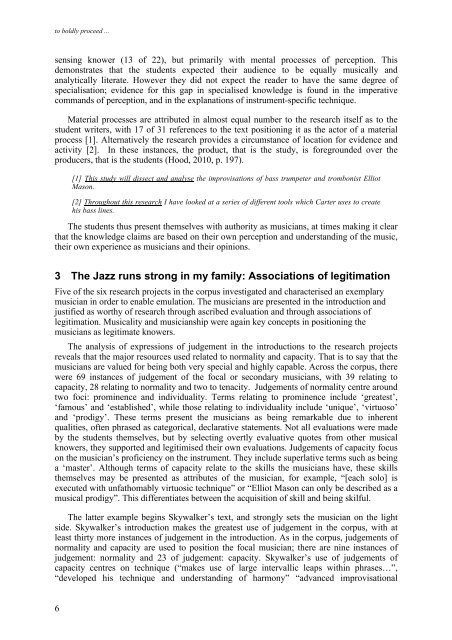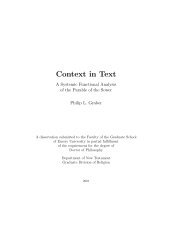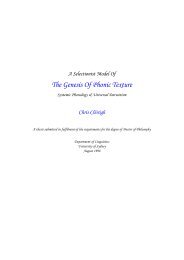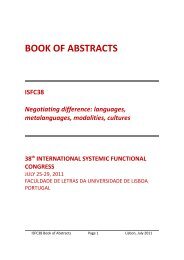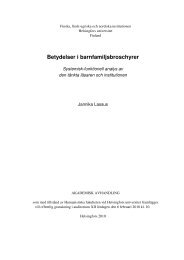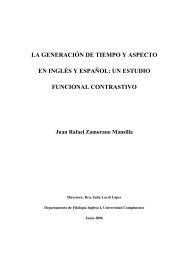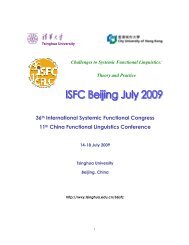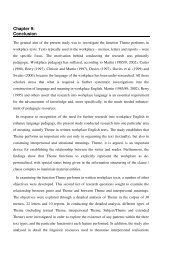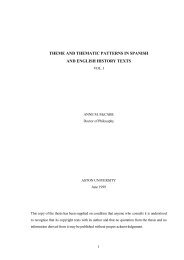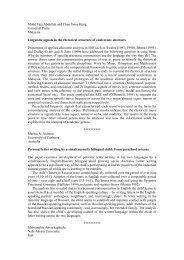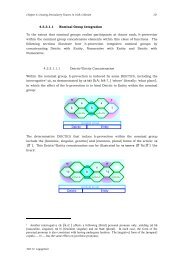the ISFC39 Proceedings - International Systemic-Functional ...
the ISFC39 Proceedings - International Systemic-Functional ...
the ISFC39 Proceedings - International Systemic-Functional ...
Create successful ePaper yourself
Turn your PDF publications into a flip-book with our unique Google optimized e-Paper software.
to boldly proceed ...sensing knower (13 of 22), but primarily with mental processes of perception. Thisdemonstrates that <strong>the</strong> students expected <strong>the</strong>ir audience to be equally musically andanalytically literate. However <strong>the</strong>y did not expect <strong>the</strong> reader to have <strong>the</strong> same degree ofspecialisation; evidence for this gap in specialised knowledge is found in <strong>the</strong> imperativecommands of perception, and in <strong>the</strong> explanations of instrument-specific technique.Material processes are attributed in almost equal number to <strong>the</strong> research itself as to <strong>the</strong>student writers, with 17 of 31 references to <strong>the</strong> text positioning it as <strong>the</strong> actor of a materialprocess [1]. Alternatively <strong>the</strong> research provides a circumstance of location for evidence andactivity [2]. In <strong>the</strong>se instances, <strong>the</strong> product, that is <strong>the</strong> study, is foregrounded over <strong>the</strong>producers, that is <strong>the</strong> students (Hood, 2010, p. 197).[1] This study will dissect and analyse <strong>the</strong> improvisations of bass trumpeter and trombonist ElliotMason.[2] Throughout this research I have looked at a series of different tools which Carter uses to createhis bass lines.The students thus present <strong>the</strong>mselves with authority as musicians, at times making it clearthat <strong>the</strong> knowledge claims are based on <strong>the</strong>ir own perception and understanding of <strong>the</strong> music,<strong>the</strong>ir own experience as musicians and <strong>the</strong>ir opinions.3 The Jazz runs strong in my family: Associations of legitimationFive of <strong>the</strong> six research projects in <strong>the</strong> corpus investigated and characterised an exemplarymusician in order to enable emulation. The musicians are presented in <strong>the</strong> introduction andjustified as worthy of research through ascribed evaluation and through associations oflegitimation. Musicality and musicianship were again key concepts in positioning <strong>the</strong>musicians as legitimate knowers.The analysis of expressions of judgement in <strong>the</strong> introductions to <strong>the</strong> research projectsreveals that <strong>the</strong> major resources used related to normality and capacity. That is to say that <strong>the</strong>musicians are valued for being both very special and highly capable. Across <strong>the</strong> corpus, <strong>the</strong>rewere 69 instances of judgement of <strong>the</strong> focal or secondary musicians, with 39 relating tocapacity, 28 relating to normality and two to tenacity. Judgements of normality centre aroundtwo foci: prominence and individuality. Terms relating to prominence include ‘greatest’,‘famous’ and ‘established’, while those relating to individuality include ‘unique’, ‘virtuoso’and ‘prodigy’. These terms present <strong>the</strong> musicians as being remarkable due to inherentqualities, often phrased as categorical, declarative statements. Not all evaluations were madeby <strong>the</strong> students <strong>the</strong>mselves, but by selecting overtly evaluative quotes from o<strong>the</strong>r musicalknowers, <strong>the</strong>y supported and legitimised <strong>the</strong>ir own evaluations. Judgements of capacity focuson <strong>the</strong> musician’s proficiency on <strong>the</strong> instrument. They include superlative terms such as beinga ‘master’. Although terms of capacity relate to <strong>the</strong> skills <strong>the</strong> musicians have, <strong>the</strong>se skills<strong>the</strong>mselves may be presented as attributes of <strong>the</strong> musician, for example, “[each solo] isexecuted with unfathomably virtuosic technique” or “Elliot Mason can only be described as amusical prodigy”. This differentiates between <strong>the</strong> acquisition of skill and being skilful.The latter example begins Skywalker’s text, and strongly sets <strong>the</strong> musician on <strong>the</strong> lightside. Skywalker’s introduction makes <strong>the</strong> greatest use of judgement in <strong>the</strong> corpus, with atleast thirty more instances of judgement in <strong>the</strong> introduction. As in <strong>the</strong> corpus, judgements ofnormality and capacity are used to position <strong>the</strong> focal musician; <strong>the</strong>re are nine instances ofjudgement: normality and 23 of judgement: capacity. Skywalker’s use of judgements ofcapacity centres on technique (“makes use of large intervallic leaps within phrases…”,“developed his technique and understanding of harmony” “advanced improvisational6


